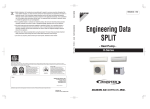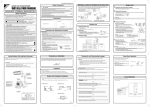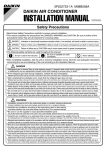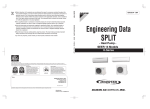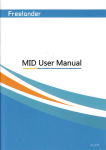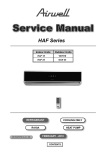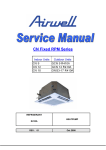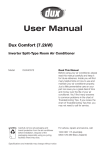Transcript
3P141697-3C M04B020A Accessories DAIKIN AIR CONDITIONER Outdoor Unit Installation 5. Accessories supplied with the outdoor unit: 6. Purging Air and Checking for Gas Leakage • When the piping work is completed, it is necessary to purge the air and check for gas leakage. (B) Drain plug (Heat pump-Models) Warning 1 (A) Installation manual 1 Safety Precautions Located on the bottom of the packing case. • Read these Safety Precautions carefully to ensure correct installation. • This manual classifies the precautions into WARNINGS and CAUTIONS. Be sure to follow all the precautions below: they are all important for ensuring safety. WARNINGS Failure to follow any of WARNING is likely to result in such grave consequences as death or serious injury. CAUTIONS Failure to follow any of CAUTION may in some cases result in grave consequences. • The following safety symbols are used throughout this manual: Be sure to establish a proper earth grounding connection. Be sure to observe this instruction. Never attempt. • After completing installation, test the unit to check for installation errors. Give the user adequate instructions concerning the use and cleaning of the unit according to the Operation Manual. WARNINGS • Installation should be left to the authorized dealer or another trained professional. Improper installation may cause water leakage, electrical shock, fire, or equipment damage. • Install the air conditioner according to the instructions given in this manual. Incomplete installation may cause water leakage, electrical shock, fire or equipment damage. • Be sure to use the supplied or exact specified installation parts. Use of other parts may cause the unit to come to lose, water leakage, electrical shock, fire or equipment damage. • Install the air conditioner on a solid base that is level and can support the unit's weight. An inadequate base or incomplete installation may cause injury or equipment damage in the event the unit falls off the base or comes loose. • Electrical work should be carried out in accordance with the installation manual and the national, state and local electrical wiring codes. Insufficient capacity or incomplete electrical work may cause electrical shock, fire or equipment damage. • Be sure to use a dedicated power circuit. Never use a power supply shared by another appliance. Follow all appropriate electrical codes. • For wiring, use a wire or cable long enough to cover the entire distance with no splices if possible. Do not use an extension cord. Do not put other loads on the power supply.Use a only a separate dedicated power circuit. (Failure to do so may cause abnormal heat, electric shock,fire or equipment damage.) Precautions for Selecting the Location 1) Choose a place strong enough to bear the weight and vibration of the unit, The location should not amplified the unit noise. 2) Choose a location where the hot air discharged from the unit and the operationing noise will not be a nuisance to the neighbors. 3) Avoid noise sensitive locations such as bedrooms to avoid future problems. 4) There must be sufficient clearance for carrying the unit into and out of the site. 5) There must be sufficient space around the air inlet and the air outlet with no obstructions to airflow. 6) The surrounding area must be free from the possibility of flammable gas leakage. 7) Install units, power cords and inter-connecting cables at least 10 feet away from television and radio sets. This is to prevent interference to images and sounds. (Noises may be heard even if they are more than 10 feet away depending on radio wave conditions.) 8) In coastal areas or other places with salty atmosphere of sulfate gas, corrosion may shorten the life of the air conditioner. 9) Do not place moisture sensitive equipment or articles under the outdoor unit condenstate drain. 1) 2) 3) 4) Do not place any substance other than the specified refrigerant (R410A) into the refrigeration cycle. When a refrigerant gas leak occurs, ventilate the room as soon and as much as possible. R410A, as well as other refrigerants, should always be recovered and never be released directly into the environment. Use a vacuum pump for R410A exclusively. Using the same vacuum pump for different refrigerants may damage the vacuum pump or the unit. • If adding additional refrigerant, perform air purging from the refrigerant pipes and indoor unit using a vacuum pump before charging additional refrigerant. • Use a hexagonal wrench (3/16”) to operate the shut-off valve rod. • All refrigerant pipe joints should be tightened with a torque wrench to the specified tightening torque. Filling a cylinder with an attached siphon Valve lids 7. Liquid shut-off valve Refrigerant Piping Work 7-1 Cautions on Pipe Handling 1) Protect the open end of the pipe against dust and moisture. Gas shut-off valve When using commercial copper pipes and fittings, observe the following: 1) Insulation material: Polyethylene foam Heat transfer rate: 0.041 to 0.052 kW/mK (0.024-0.030 Btu/fth˚F) Refrigerant gas pipe’s surface temperature reaches 230˚F max. Choose heat insulation materials that will withstand this temperature. 2) Be sure to insulate both the gas and liquid piping and to provide insulation dimensions as below. 1) Connect projection side (on which worm pin is pressed) of charging hose (which comes from gauge manifold) to gas shut-off valve’s service port. 2) Fully open gauge manifold’s low-pressure valve (Lo) and completely close its high-pressure valve (Hi). (High-pressure valve subsequently requires no operation.) Gas side NOTE Do not install unit by hanging from a ceiling or stacking units. O.D. 3/8 in 3) Do vacuum pumping and make sure that the vacuum pressure gauge reads – 29.9 inHg *1. • If any refrigerant has leaked out during the installation work, ventilate the room. (The refrigerant produces a toxic gas if exposed to flames.) • After all installation is complete, check to make sure that no refrigerant is leaking. (The refrigerant produces a toxic gas if exposed to flames.) • During pump-down, stop the compressor before removing the refrigerant piping. If the compressor is still running and the shut-off valve is open during pump-down, air will be sucked in when the refrigerant piping is removed, causing abnormally high pressure which could lead to equipment damage or and personal injury. • During installation, attach the refrigerant piping securely before running the compressor. If the compressor is not attached and the shut-off valve is open during pump-down, air will be sucked in when the compressor is run, causing abnormally high pressure whichcould lead to equipment damage and personal injury. Caution When operating the air conditioner in a outdoor temperature below, be sure to follow the instructions described below. 1) To prevent exposure to wind, install the outdoor unit with its suction side facing the wall. 2) Never install the outdoor unit at a site where the suction side may be exposed directly to wind. 3) To prevent exposure to wind, it is recommended to install a baffle plate on the air discharge side of the outdoor unit. 4) In heavy snowfall areas, select an installation site where the snow will not affect the unit. Incomplete or inadequate grounding may cause equipment damage, or electrical shock and personal injury. A high surge current from lightning or other sources may cause damage to the air conditioner. Construct a large canopy. Construct a pedestal. Install the unit high enough off the ground to prevent burying in snow. If the gas leaks and builds up around the unit, it may catch fire. • Establish drain piping according to the instructions of this manual. Inadequate piping may cause water damage. • Note for installing the outdoor unit. (For heat pump model only.) In regions of the country where the outside temperature is at or • Ensure the strength and level of the installation will not cause any operating vibration or noise after installed. • In accordance with the foundation drawing, fix the unit securely by means of the foundation bolts. (Prepare four sets of 3/8” or 7/16” foundation bolts, nuts and washers each which are available on the market.) • It is best to screw in the foundation bolts until their length are 3/4” from the foundation surface. 3/4” • Tighten the flare nut according to the specified torque. A torque wrench should be used. If the flare nut is tightened too much, the flare nut may crack over time and cause refrigerant leakage. • Be very careful about product transportation. Some products use PP bands for packaging. Do not use any PP bands for a means of transportation. It is dangerous. • Never perform outdoor unit piping connection work when it is raining. Outdoor Unit Installation Drawings 1. 65 ft 49 ft Additionl refrigerant required for refrigerant pipe exceeding 33 ft in length. 2. Gas pipe O.D. 3/8” O.D. 1/4” 3. Installing Outdoor Unit Drain Work (Heat pump-Models) Failure to do so may result in reduced perfomance. Drain-water hole Bottom frame Drain plug Hose (available commercially, inner dia. 16mm) Flaring the Pipe End 1) Cut the pipe end with a pipe cutter. 2) Remove burrs with the cut surface facing downward so that the chips do not enter the pipe. 3) Put the flare nut on the pipe. 4) Flare the pipe. 5) Check that the flaring is properly made. * Be sure to add the proper amount of additional refrigerant. (Cut exactly at right angles.) Remove burrs Set exactly at the position shown below. A A Flare tool for R410A Conventional flare tool Clutch-type Clutch-type (Rigid-type) Wing-nut type (Imperial-type) 0 ~ 0.020” 0.039 ~ 0.059” 0.059 ~ 0.079” Check Flare’s inner surface must be flaw-free. 250 mm from wa In sites with poor drainage, use block bases for outdoor unit. Adjust foot height until the unit is leveled. Otherwise, water leakage or pooling of water may occur. (Foot b 22 9/1 6 olt-hole centre s) 4 1/8 (From unit's s Allow space for piping and electrical servicing. unit: in 1) 2) 3) 4) 5) 6) Spanner Walls facing three sides More than 3 15/16 Top view Gas pipe insulation Thickness 0.393 in Min. Liquid pipe insulation Finishing tape Drain hose Flare nut tightening torque Gas side Liquid side 3/8 inch 1/4 inch 24.1~29.4ft • Ibf 10.4~12.7ft • Ibf Hexagonal wrench Remove the valve lid from liquid shut-off valve and gas shut-off valve. Carry out forced cooling operation. After five to ten minutes, close the liquid shut-off valve with a hexagonal wrench. After two to three minutes, close the gas shut-off valve and stop forced cooling operation. Gas shut-off valve 2 Valve cap tightening torque Gas side Liquid side 3/8 inch 1/4 inch 15.9~20.2ft • Ibf 15.9~20.2ft • Ibf After closing the liquid shut-off valve, close the gas shut-off valve within three minutes, then stop the forced operation. 1-1 Measure the supply voltage and make sure that it falls in the specified range. 1-2 Trial operation should be carried out in eitr cooling or heating mode. • In cooling mode, select the lowest programmable temperature; in heating mode, select the highest programmable temperature. 1) Trial operation may be disabled in either mode depending on the room temperature. 2) After trial operation is complete, set the temperature to a normal level (78˚F to 82˚F in cooling mode, 68˚F to 75˚F in heating mode). 3) For protection, the unit disables restart operation for 3 minutes after it is turned off. 1-3 Carry out the test operation in accordance with the Operation Manual to ensure that all functions and parts, such as louver movement, are working properly. • The air conditioner requires a small amount of power in its standby mode. If the system is not to be used for Outdoor unit 1 23 Trial Operation and Testing. L1 L2 some time after installation, shut off the circuit breaker to eliminate unnecessary power consumption. 10 m, use 2.0-mm wires. • If the circuit breaker trips to shut off the power to the air conditioner, the system will restore the original Indoor unit 3 2 1 Safety breaker 15A Earth leakage circuit breaker operation mode when the circuit breaker is opened again. Power supply 60Hz 208/230V 2. Earth Test Items. 3 2 Power supply terminal block 3 Shape wires so that the service lid and shut-off valve cover fit securely. Conduit mounting plate Use the specified wire type and connect it securely. Conduit Lock nut Observe the notes mentioned below when wiring to the power supply terminal board. Round crimp-style Precautions to be taken for power supply wiring. terminal (Use a round crimp-style terminal for connection to the power supply terminal board. In case it cannot be used due to unavoidable reasons, be sure to observe the following instruction.) Electric Wire When connecting the connection wires to the terminal board using a single core wire, be sure to perform curling. Problems with the work may cause heat and fires. Strip wire end to this point. 7.9~10.8ft • Ibf Valve lid Caution Test Items 1 Close Using the main unit’s remote control 1) Press the “operation/stop” button. (Operation will start.) 2) Press the temperature button and the “operation select” button at the same time. 3) Press the “operation select” button twice. ( will be displayed and the unit will enter test run mode.) 4) Press the “operation select” button to return the operation mode to cooling. • Test run mode will stop automatically after around 30 minutes. To force a test run to stop, press the operation/stop button. 1. Warning indoor and outdoor units so that the terminal numbers match. Tighten the terminal screws securely. We recommend a flathead screwdriver be used to tighten the screws. The screws are packed with the terminal board. Liquid shut-off valve Run Test and Final Check Excessive strip length may cause electrical shock or leakage. Good More than 11 13/16 Top view Stripping wire at terminal block Side view Liquid pipe n 1) Do not use spliced wires, stand wires, extension cords, or starbust connections, as they may cause overheating, electrical shock, or fire. Follow all Local, and State electrical codes. 2) Do not use locally purchased electrical parts inside the product. (Do not overload the circuit by adding drain pump or other electrical equipment to unit terminals.) Doing so may cause electric shock or fire. 3) Be sure to install an earth leak detector. (One that can handle higher harmonics.) (This unit uses an inverter, which means that it must be used an earth leak detector capable handling harmonics in order to prevent malfunctioning of the earth leak detector itself.) 4) When carrying out wiring connection, take care not to pull at the conduit. More than 5 7/8 More than 1 15/16 More than 1 15/16 Not less than 15 min. Caution Flare nut Service port cap tightening torque More than 1 15/16 Not less than 10 min. Piping union • Where a wall or other obstacle is in the path of outdoor unit’s intake or exhaust airflow, follow the installation guidelines below. • For any of the below installation patterns, the wall height on the exhaust side should be 4 ft or less. 47 3/16 or less Run time Refrigerant Piping Installation Guidelines More than 5 7/8 More than 3 15/16 More than 50 feet Do not use mineral oil on flared part. Prevent mineral oil from getting into the system as this would reduce the unit life. Never use piping which has been used for previous installations. Only use parts which are provided with the unit. Do never install a refrigerant drier to this unit. The drying material may dissolve and damage the system. Incomplete or improper flaring may cause refrigerant gas leakage. Coat here with refrigeration machine oil More than 1 15/16 The pipe end must be evenly flared in a perfect circle. 1) Align the centers of both flares and tighten the flare nuts 3 or 4 turns by hand. Then tighten them fully with the torque wrenches. • Use torque wrenches when tightening the flare nuts to prevent damage to the flare nuts and escaping gas. 2) To prevent gas leakage, apply refrigeration machine oil on both inner and outer surfaces of the flare. (Use Torque wrench refrigeration oil for R410A) Where there is a danger of the unit falling, use foot bolts, or wires. Walls facing two sides Up to 50 feet Warning 4. ide) Wall facing one side Pipe length 1 How to attach the service lid. Insert the upper part of the service lid into the outdoor unit to install. Tighten the screws. 4 e 1/ t-hol 12 t bol o Fo ntres ce I.D. 0.315-0.393 in Using the indoor unit operation/stop button Press the indoor unit operation/stop button for at least five seconds. (Operation will start.) • Forced cooling operation will stop automatically after around 15 minutes. To force a test run to stop, press the indoor unit operation/stop button. *1. Pipe length vs. vacuum pump run time Make sure that the flare nut is fitted. Service lid How to remove the service lid. Remove the screw on the service lid. Slide the lid downward to remove it. ll I.D. 0.472-0.590 in n 8) Tighten valve lids and service port caps for the liquid and gas shut-off valves with a torque wrench at the specified torques. • Do not turn ON the safety breaker until all work is completed. 1) Strip the insulation from the wire (3/4 in). 2) Connect the connection wires between the When wire length exceeds Flaring Die 1) 2) 3) 4) 6) Turn the liquid shut-off valve’s rod 90 degrees counterclockwise with a hexagonal wrench to open valve. Close it after 5 seconds, and check for gas leakage. Using soapy water, check for gas leakage from indoor unit’s flare and outdoor unit’s flare and valve rods. After the check is complete, wipe all soapy water off. Wiring 1) Use drain plug for drainage. 2) If the drain port is covered by a mounting base or floor surface, place additional foot bases of at least 1 1/4” in height under the outdoor unit’s feet. 3) In cold areas, do not use a drain hose with the outdoor unit. (Otherwise, drain water may freeze, impairing heating performance.) 0.22 oz/ft Liquid pipe Liquid pipe thermal insulation Gas pipe In order to protect the environment, be sure to pump down when relocating or disposing of the unit. *2. If the vacuum pressure gauge pointer swings back, refrigerant may have water content or a loose pipe joint may exists. Check all pipe joints and retighten nuts as needed, then repeat steps 2) through 4). 1) When installing the outdoor unit, refer to “Precautions for Selecting the Location” and the “Outdoor Unit Installation Drawings.” 2) If drain work is necessary, follow the procedures below. 09 / 12 class Max. allowable height 5) Remove covers from liquid shut-off value and gas shut-off valve. Outdoor Unit Installation Wrap the insulation pipe with the finishing tape from bottom to top. Model 09/12 class Inter-unit wiring Pump Down Operation 7) Disconnect charging hose from gas shut-off valve’s service port, then fully open liquid and gas shut-off valves. (Do not attempt to turn valve rod beyond its stop.) below the freezing point, the drain may freeze. If so, it is recommended that an electric heater be installed in order to protect the drain from freezing. Max. allowable length Gas pipe thermal insulation How to force cooling operation mode Precautions on Installation • Be sure to install a ground fault circuit interrupter breaker. Failure to install a ground fault circuit interrupter breaker may result in electrically shocks or personal injury. • Do not install the air conditioner where gas leakage would be exposed to open flames. O.D. 1/4 in 4) Close gauge manifold's low-pressure valve (Lo) and stop vacuum pump. (Keep this state for a few minutes to make sure that the vacuum pressure gauge pointer does not swing back.)*2. • Securely install the outdoor unit terminal cover (panel). If the terminal cover (panel) is not installed properly, dust or water may enter the outdoor unit and fire or electric shock may reslt. • Install an leak circuit breaker, as required. If an leak circuit breaker is not installed, electric shock may result. • Be sure to establish a ground. Do not ground the unit to a utility pipe, arrester, or telephone ground. CAUTIONS If no flare cap is available, cover the flare mouth with tape to keep dirt or water out. 3) Use separate thermal insulation pipes for gas and liquid refrigerant pipes. Install covers over the wires. Incomplete cover installation may cause terminal overheating, electrical shock,fire or equipment damage. (Any presence of air or other foreign substance in the refrigerant circuit causes an abnormal pressure rise which may result in rupture, resulting in injury.) Liquid side Thickness 0.031 in Firmly clamp the interconnecting wires so their terminals receive no external stresses. Incomplete connections or clamping may cause terminal overheating, fire or euipment damage. • After connecting all wiring be sure to shape the cables so that they do not put undue stress on the electrical covers, panels or terminals. • When installing or relocating the system, be sure to keep the refrigerant circuit free from all substances other than the specified refrigerant (R410A), such as air. Rain Selection of Copper and Heat Insulation materials 7-2 Vacuum pump Service port Wall Be sure to place a cap. 2) All pipe bends should be as gentle as possible. Use a pipe bender for bending. (Bending radius should be 1 1/4” to 1 5/8” mm or larger.) Charging hoses 09/12 class • Use the specified types of wires for electrical connections between the indoor and outdoor units. Follow all state and local electrical codes. Turn the cylinder upside-down when filling. There is a siphon pipe inside, so the cylinder need not be upside-down to fill with liquid. • Be sure to use the R410A tools to ensure pressure and to prevent foreign objects entering. Gauge manifold Highpressure valve Filling other cylinders Stand the cylinder upright when filling. Compound Pressure pressure gauge meter Low-pressure valve Refilling The Refrigerant Check the type of refrigerant to be used on the machine nameplate. Precautions when adding R410A Fill from the liquid pipe in liquid form. It is a mixture of refrigerant, so adding it in gas form may cause the refrigerant composition to change, preventing normal operation. 1) Before filling, check whether the cylinder has a siphon attached or not. (It should have something like “liquid filling siphon attached” displayed on it.) Unit: in 3) Pull the wire and make sure that it is tight. Then fix the wire in place with a strain relief. Wrong Symptom (diagnostic display on RC) Indoor and outdoor units are installed properly on solid bases. Fall, vibration, noise No refrigerant gas leaks. Incomplete cooling/heating function Refrigerant gas and liquid pipes and indoor drain hose extension are thermally insulated. Water leakage Drain line is properly installed. Water leakage System is properly ground to earth. Electrical leakage The specified wires are used for interconnecting wire connections. Inoperative or burn damage Indoor or outdoor unit’s air intake or exhaust has clear path of air. Shut-off valves are opened. Incomplete cooling/heating function Indoor unit properly receives remote control commands. Inoperative Check
